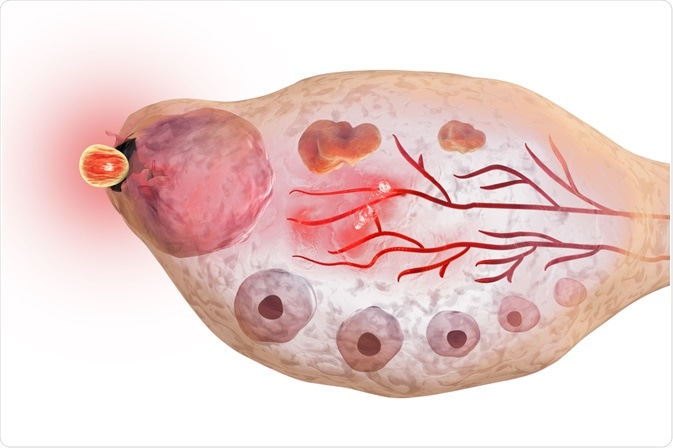At the beginning of the menstrual cycle, the follicular phase involves the development of the follicle that contains the egg.
Traditionally it was believed that a follicle underwent a series of changes until the membrane eventually ruptured and the egg was released to travel through the fallopian tubes towards the uterus to be fertilized. However, recent research suggests that there may be several waves of follicle development during this phase, with two or more follicles developing and only the last rupturing and leading to ovulation.

Image Credit: Kateryna Kon / Shutterstock.com
Follicular development in animals
Originally, the findings seen in the menstrual cycle of mammals such as cows and sheep prompted researchers to reconsider the human menstrual cycle and the possibility of follicle waves.
Although the exact procedure of the follicular phase and the involvement of developmental waves are not precisely known, the following is an overview of what is believed to occur in cows:
- A surge in follicle stimulation hormone (FSH)
- Several follicles begin to develop and one becomes dominant
- High levels of progesterone prevent follicle from leading to ovulation
- A second surge in FSH
- Another wave of follicles develop and another becomes dominant
- Progesterone levels drop
- Spike in luteinizing hormone (LH) causes the follicle to rupture and initiate ovulation
Theoretically, it is possible for several waves to occur before the follicle rupture and ovulation occurs, provided that the progesterone levels remain high.
This phenomenon of waves throughout the follicular phase as the egg develops has been observed in both cows and horses. As a result, it has led researchers to reconsider the process in humans.
Follicular waves in humans
One scientific study examined the characteristics of follicular waves in women and found that 76% of women tended to display two follicular wave developments before ovulation, whilst the remaining women had three waves. The majority of women in both groups had minor follicle development in the earlier waves, with the final wave being major. However, some also had a major development in earlier waves.
The precise process of follicular development in humans is believed to differ somewhat from that of cows and horses. In particular, the reason for the earlier follicular waves failing to mature and lead to ovulation does not seem to be related to progesterone levels, which remain low through the phase. The mechanism is not well understood and requires more research to be explained adequately.
Follicular development and ovulation
In order for ovulation to occur, the follicle in the ovaries is required to mature and rupture to allow for the released egg to be fertilized.
It is evident that for this to occur, there are particular conditions of the follicle that need to be met. If the follicle is not sufficient, it loses traction and another follicle begins developing to form a second developmental wave.
When the follicle has matured sufficiently, it ruptures and ovulation begins. It is possible for a woman to have two follicular waves in one menstrual cycle and three waves in the next, as it depends on the development of the follicle and whether it is suitable to lead to ovulation.
References
Further Reading
Last Updated: Jan 13, 2023